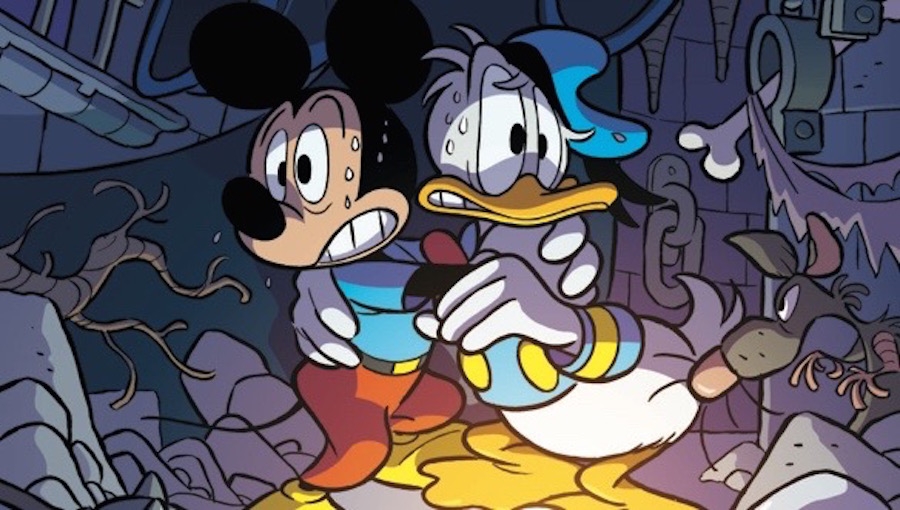IDW’s Donald and Mickey reads less like old stories involving the characters and more like a cross of stories between the old ’60s Batman television series and Hannah Barbara cartoons like Scooby-Doo which became infamous. Of course, these stories obviously have Donald Duck and Mickey Mouse in them, but it’s a tad confusing when the villain in Mickey’s story seems similar to both The Riddler and a random ghoul from an episode of Scooby-Doo. In one direct reference, writer Andrea Castellan makes in “The Big Fat Flat Blot Plot,” she names one of the cops as Chief O’Hara, a character who had great fame in Batman on Fox during the 1960s.
It’s confusing as to why Donald and Mickey does not stick closer to its original characters and stories it’s known for. Why the writers – Castellan, Kari Korhonen, and Frank Jonker – feel they need to go to other properties and explicitly copy the material does not make much sense. Nevertheless, as stories that combine some fun elements from the Batman ’60s series and Scooby-Doo, they do entertain quite a bit; however, they become confusing in how overplotted they truly are.
In “The Saucer’s a Menace,” the first of two Donald Duck stories, it’s confusing to see how the plot of how Donald laying in bed connects to a cop on the force and why Chief Piggum is actually interested in the hot dogs and tracking down Donald Duck. With many of the characters having their names mentioned once in the story, it becomes even more confusing to follow the characters. Then, some random cop comes into the chief’s office and we still really have no justification for his presence in the story. It immediately goes to two random people walking on the street.
One of them works at the radio station and makes a mistake with the speaker on the radio, which wakes Donald Duck up from his sleep with negative news about some of his cooking. It’s all a bit convoluted and doesn’t make a great bit of sense. Donald attempts to eventually find Gyro Gearloose and then it’s connected to some random baseball game. Somehow, Donald Duck finds himself on a train during a chase scene, and then a guy is arrested.
The plot jumps around so much with random characters being introduced that it’s difficult to follow all of the moments Korhonen adds into the story. While the art by Daniel Branca is great, it doesn’t help the story as it only contributes to the confusion.
“ The Big Fat Flat Blot Plot” is a tad better as it clearly has a plot it follows with Mickey, Goofy, and Chief O’Hara. In that sense, it’s nice to see and makes the story enjoyable. While it still struggles with a few unnecessary moments, what begins with the cards from someone who could be The Riddler turns out to be an interesting game of cat and mouse, which puts the entire police force on alert. They continue the chase throughout the story, following clues until Mickey during later parts of the story and its chase, finding himself in the “one-dimensional chateau” the blot seems to call home. Mickey is trapped in a prison there. Such dilemma adds peril and intrigue to a story about who exactly the blot is and what’s happening throughout the story.
Castellan does a much better job of focusing on one story she wants to tell a part from many different stories that don’t seem connected by truly anything. What’s a great end to the story is that it’s Goofy who saves the day. He’s the unexpected hero and that adds a nice touch to his character. It would have been better if they avoided references to Batman and Scooby-Doo, but the story stands on its own.
Gearloose actually appears in the next story, “Yard Wars.” It’s a very short story. In fact, it fails to leave much of an impression. It may not be the fault of Jonke,r as he seems to have only been given a certain amount of pages to work with. Yet, at the end of the story, it’s mostly Donald Duck and his neighbor playing pranks on one another and attempting to one up each other. It may be making references to the original film that portrayed strife between two neighbors – Neighbors with John Belushi and Dan Akroyd; however, it seems to reference loosely some parts of that film. Otherwise, there are a few laughs but it makes sense as to why Castellan’s story was in the middle.
Not only was Castellan’s writing a notch above that of Korhonen and Jonker’s, but the art by Lorenzo Pastrovicchio served the story better than that of Branca’s or Bas Heymans. Part of that goes with the way the other writers constructed the confusing or short stories they created. While they all captured the Disney style of art well, there was without a doubt a lot more to like about Castellan and Pastrovicchio’s story than the other ones. Here’s hoping more Disney writers and artists are looking to those two as the bar for storytelling. There’s always a way to improve the writing and art of a story.
Tommy Zimmer is a writer whose work has appeared online and in print. His work covers a variety of topics, including politics, economics, health and wellness, addiction and recovery, and the entertainment industry.

